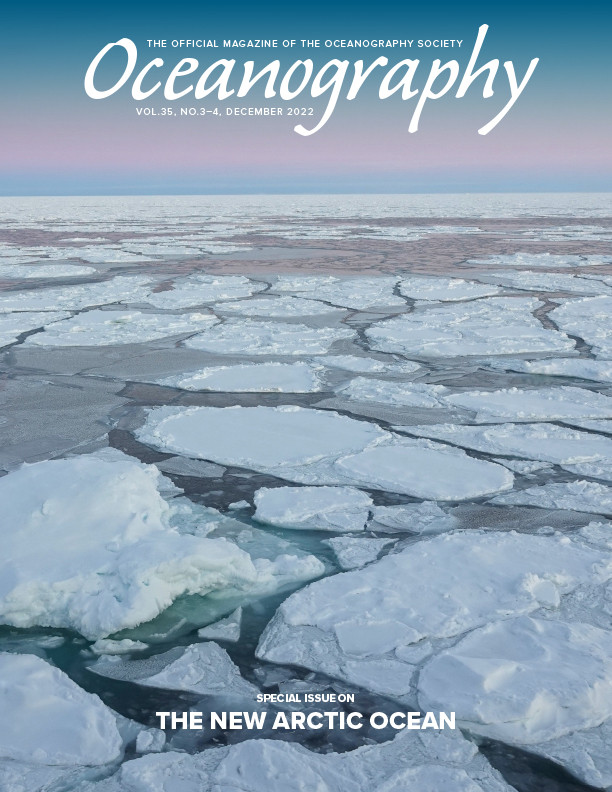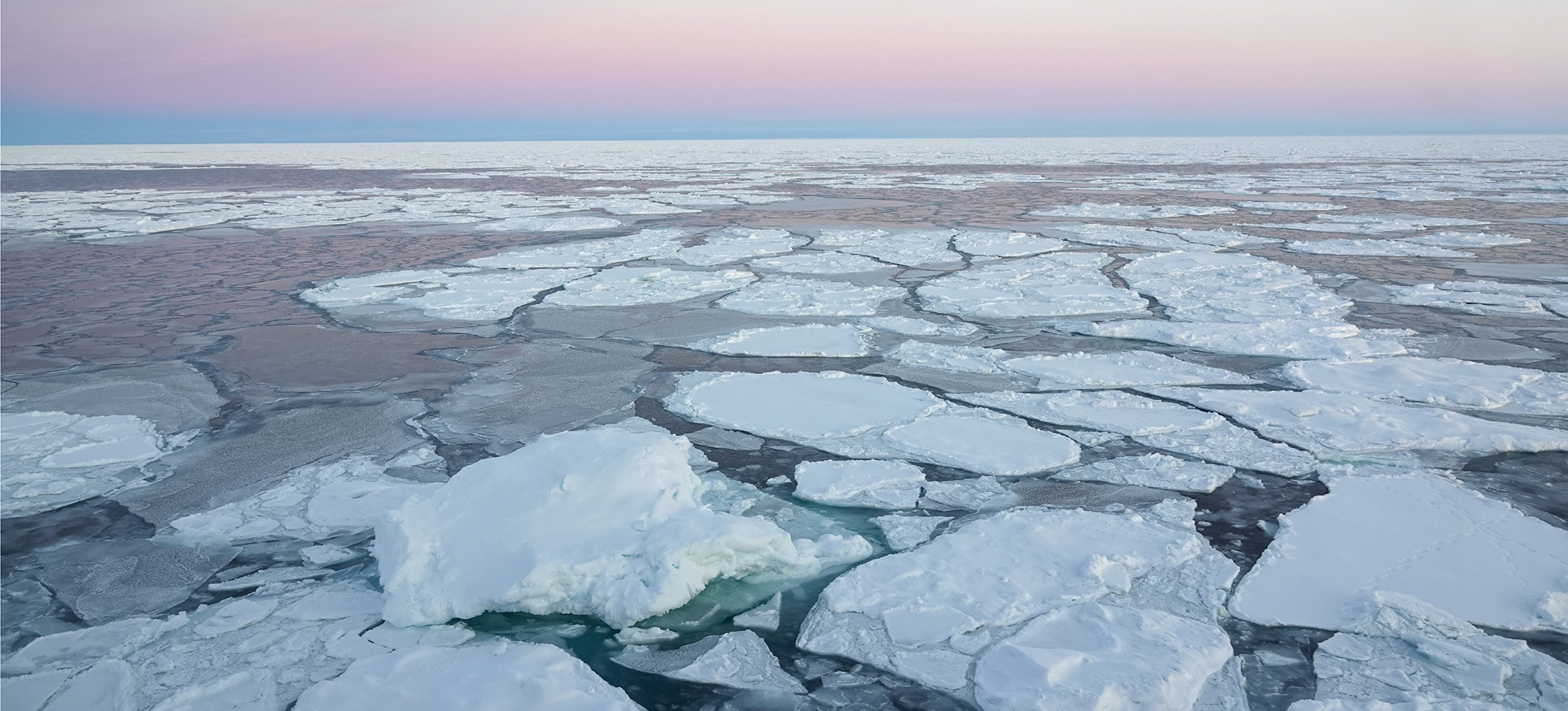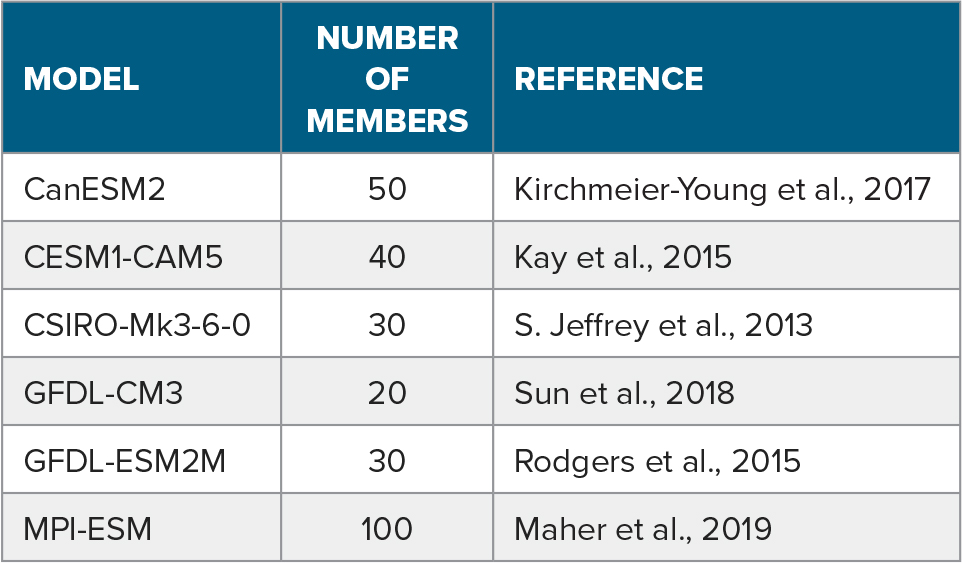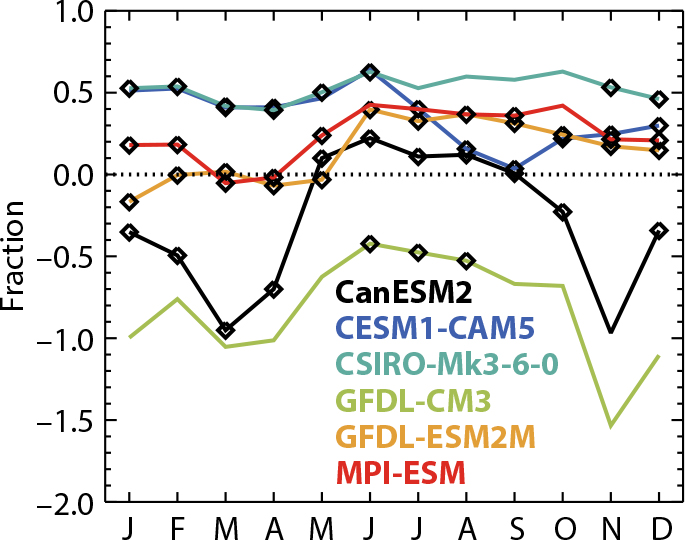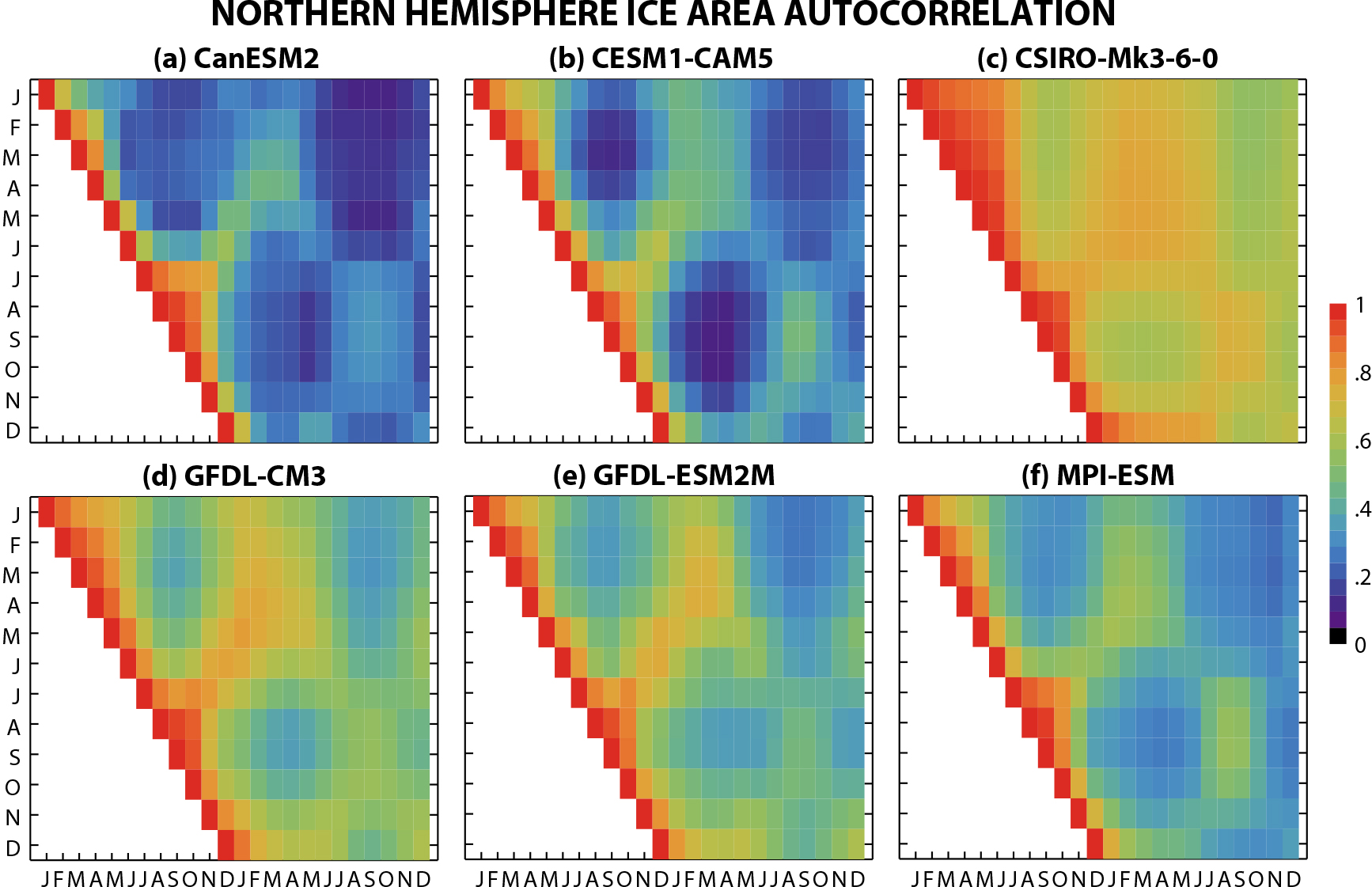Blanchard-Wrigglesworth, E., K.C. Armour, C.M. Bitz, and E. DeWeaver. 2011a. Persistence and inherent predictability of Arctic sea ice in a GCM ensemble and observations. Journal of Climate 24:231–250, https://doi.org/10.1175/2010JCLI3775.1.
Blanchard-Wrigglesworth, E., C.M. Bitz, and M.M. Holland. 2011b. Influence of initial conditions and climate forcing on predicting Arctic sea ice. Geophysical Research Letters 38(18), https://doi.org/10.1029/2011GL048807.
Blockley, E.W., and K.A. Peterson. 2018. Improving Met Office seasonal predictions of Arctic sea ice using assimilation of CryoSat-2 thickness. The Cryosphere 12(11):3,419–3438, https://doi.org/10.5194/tc-12-3419-2018.
Bonan, D., F. Lehner, and M.M. Holland. 2021. Partitioning uncertainty in projections of Arctic sea ice. Environmental Research Letters 16:044002, https://doi.org/10.1088/1748-9326/abe0ec.
Briegleb, B.P., and B. Light. 2007. A Delta-Eddington Multiple Scattering Parameterization for Solar Radiation in the Sea Ice Component of the Community Climate System Model. NCAR Technical Note NCAR/TN-472+STR, National Center for Atmospheric Research, 108 pp.
Bushuk, M., X. Yang, M. Winton, R. Msadek, M. Harrison, A. Rosati, and R. Gudgel. 2019. The value of sustained ocean observations for sea ice predictions in the Barents Sea. Journal of Climate 32(20):7,017–7,035, https://doi.org/10.1175/JCLI-D-19-0179.1.
Day, J.J., E. Hawkins, and S. Tietsche. 2014a. Will Arctic sea ice thickness initialization improve seasonal forecast skill? Geophysical Research Letters 41(21):7,566–7,575, https://doi.org/10.1002/2014GL061694.
Day, J.J., S. Tietsche, and E. Hawkins. 2014b. Pan-Arctic and regional sea ice predictability: Initialization month dependence. Journal of Climate 12:4,371–4,390, https://doi.org/10.1175/JCLI-D-13-00614.1.
Deser, C., F. Lehner, K.B. Rodgers, T. Ault, T.L. Delworth, P.N. DiNezio, A. Flore, C. Frankignoul, J.C. Fyfe, D.E. Horton, and others. 2020. Insights from Earth system model initial-condition large ensembles and future prospects. Nature Climate Change 10:277–286, https://doi.org/10.1038/s41558-020-0731-2.
Ding, Q., A. Schweiger, M. L’Heureux, E.J. Steig, D.S. Battisti, N.C. Johnson, E. Blanchard-Wrigglesworth, S. Po-Chedley, Q. Zhang, K. Harnos, and others. 2019. Fingerprints of internal drivers of Arctic sea ice loss in observations and model simulations. Nature Geoscience 12:28–33, https://doi.org/10.1038/s41561-018-0256-8.
Duarte, P., A. Meyer, L.M. Olsen, H.M. Kauko, P. Assmy, A. Rösel, P. Itkin, S.R. Hudson, M.A. Granskog, S. Gerland, and others. 2017. Sea ice thermohaline dynamics and biogeochemistry in the Arctic Ocean: Empirical and model results. Journal of Geophysical Research: Biogeosciences 122:1,632–1,654, https://doi.org/10.1002/2016JG003660.
Eicken, H. 2013. Arctic sea ice needs better forecasts. Nature 497(7450):431–433, https://doi.org/10.1038/497431a.
England, M.R., I. Eisenman, N.J. Lutsko, and T.J.W. Wagner. 2021. The recent emergence of Arctic amplification. Geophysical Research Letters 48(15): e2021GL094086, https://doi.org/10.1029/2021GL094086.
Eyring, V., S. Bony, G.A. Meehl, C.A. Senior, B. Stevens, R.J. Stouffer, and K.E. Taylor. 2016. Overview of the Coupled Model Intercomparison Project Phase 6 (CMIP6) experimental design and organization. Geoscientific Model Development 9:1,937–1,958, https://doi.org/10.5194/gmd-9-1937-2016.
Flocco, D., D. Schroeder, D.L. Feltham, and E.C. Hunke. 2012. Impact of melt ponds on Arctic sea ice simulations from 1990 to 2007. Journal of Geophysical Research: Oceans 117(C9), https://doi.org/10.1029/2012JC008195.
Guemas, V., E. Blanchard-Wrigglesworth, M. Chevallier, J.J. Day, M. Déqué, F.J. Doblas-Reyes, N.S. Fučkar, A. Germe, E. Hawkins, S. Keeley, and others. 2016. A review on Arctic sea-ice predictability and prediction on seasonal to decadal time-scales. Quarterly Journal of the Royal Meteorological Society 142(695):546–561, https://doi.org/10.1002/qj.2401.
Hawkins, E., and R. Sutton. 2012. Time of emergence of climate signals. Geophysical Research Letters 39(1), https://doi.org/10.1029/2011GL050087.
Herman, A. 2016. Discrete-Element bonded-particle Sea Ice model DESIgn, version 1.3a – Model description and implementation. Geoscientific Model Development 9:1,219–1,241, https://doi.org/10.5194/gmd-9-1219-2016.
Hibler, W.D. III. 1979. A dynamic thermodynamic sea ice model. Journal of Physical Oceanography 9(4):815–846, https://doi.org/10.1175/1520-0485(1979)009<0815:ADTSIM>2.0.CO;2.
Holland, M.M., C.M. Bitz, E.C. Hunke. W.H. Lipscomb, and J.L. Schramm. 2006. Influence of the sea ice thickness distribution on polar climate in CCSM3. Journal of Climate 19:2,398–2,414, https://doi.org/10.1175/JCLI3751.1.
Holland, M.M., and L. Landrum. 2015. Factors affecting projected Arctic surface shortwave heating and albedo change in coupled climate models. Philosophical Transactions of the Royal Society A 373:20140162, https://doi.org/10.1098/rsta.2014.0162.
Holland, M.M., L. Landrum, D. Bailey, and S.J. Vavrus. 2019. Changing seasonal predictability of Arctic summer sea ice area in a warming climate. Journal of Climate 32(16):4,963–4,979, https://doi.org/10.1175/JCLI-D-19-0034.1.
Hunke, E.C., and J.K. Dukowicz. 1997. An elastic-viscous-plastic model for sea ice dynamics. Journal of Physical Oceanography 27(9):1,849–1,867, https://doi.org/10.1175/1520-0485(1997)027<1849:AEVPMF>2.0.CO;2.
Hunke, E.C., D.A. Hebert, and O. Lecomte. 2013. Level-ice melt ponds in the Los Alamos sea ice model, CICE. Ocean Modelling 71:26–42, https://doi.org/10.1016/j.ocemod.2012.11.008.
Hunke, E., R. Allard, P. Blain, E. Blockley, D. Feltham, T. Fichefet, G. Garric, R. Grumbine, J.-F. Lemieux, T. Rasmussen, and others. 2020. Should sea-ice modeling tools designed for climate research be used for short-term forecasting? Current Climate Change Reports 6:121–136, https://doi.org/10.1007/s40641-020-00162-y.
Jahn, A., J.E. Kay, M.M. Holland, and D.M. Hall. 2016. How predictable is the timing of a summer ice-free Arctic? Geophysical Research Letters 43(17):9,113–9,9120, https://doi.org/10.1002/2016GL070067.
Jahn, A. 2018. Reduced probability of ice-free summers for 1.5°C compared to 2°C warming. Nature Climate Change 8:409–413, https://doi.org/10.1038/s41558-018-0127-8.
Jeffery, N., M.E. Maltrud, E.C. Hunke, S. Wang, J. Wolfe, A.K. Turner, S.M. Burrows, X. Shi, W.H. Lipscomb, W. Maslowski, and K.V. Calvin. 2020. Investigating controls on sea ice algal production using E3SMv1.1-BGC. Annals of Glaciology 61(82):51–72, https://doi.org/10.1017/aog.2020.7.
Jeffrey, S., L. Rotstayn, M. Collier, S. Dravitzki, C. Hamalainen, C. Moesender, K. Wong, and J. Syktus. 2013. Australia’s CMIP5 submission using the CSIRO-Mk3.6 model. Australian Meteorological and Oceanographic Journal 63:1–13.
Kay, J.E., M.M. Holland, and A. Jahn. 2011. Inter-annual to multi-decadal Arctic sea ice extent trends in a warming world. Geophysical Research Letters 38(15), https://doi.org/10.1029/2011GL048008.
Kay, J.E., C. Deser, A. Phillips, A. Mai, C. Hannay, G. Strand, J.M. Arblaster, S.C. Bates, G. Danabasoglu, J. Edwards, and others. 2015. The Community Earth System Model (CESM) large ensemble project: A community resource for studying climate change in the presence of internal climate variability. Bulletin of the American Meteorological Society 96:1,333–1,349, https://doi.org/10.1175/BAMS-D-13-00255.1.
Keen, A., E. Blockley, D.A. Bailey, J. Boldingh Debernard, M. Bushuk, S. Delhaye, D. Docquier, D. Feltham, F. Massonnet, S. O’Farrell, and others. 2021. An inter-comparison of the mass budget of the Arctic sea ice in CMIP6 models. The Cryosphere 15:951–982, https://doi.org/10.5194/tc-15-951-2021.
Kirchmeier-Young, M.C., F.W. Zwiers, and N.P. Gillett. 2017. Attribution of extreme events in Arctic Sea ice extent. Journal of Climate 30:553–571, https://doi.org/10.1175/JCLI-D-16-0412.1.
Krishnamurthy, V. 2019. Predictability of weather and climate. Earth and Space Science 6:1,043–1,056, https://doi.org/10.1029/2019EA000586.
Landrum, L., and M.M. Holland. 2020. Extremes becoming routine in an emerging New Arctic. Nature Climate Change 10:1,108–1,115, https://doi.org/10.1038/s41558-020-0892-z.
Lecomte, O., T. Fichefet, M. Vancoppenolle, F. Domine, F. Massonnet, P. Mathiot, S. Morin, and P.Y. Barriat. 2013. On the formulation of snow thermal conductivity in large scale sea ice models. Journal of Advances in Modeling Earth Systems 5:542–557, https://doi.org/10.1002/jame.20039.
Lemieux, J.-F., F. Dupont, P. Blain, F. Roy, G.C. Smith, and G.M. Flato. 2016. Improving the simulation of landfast ice by combining tensile strength and a parameterization for grounded ridges. Journal of Geophysical Research: Oceans 121:7,354–7,368, https://doi.org/10.1002/2016JC012006.
Lipscomb, W.H., and E.C. Hunke. 2004. Modeling sea ice transport using incremental remapping. Monthly Weather Review 132(6):1,341–1,354, https://doi.org/10.1175/1520-0493(2004)132<1341:MSITUI>2.0.CO;2.
Maher, N., S. Milinski, L. Suarez-Guitierrez, M. Botzet, M. Dobrynin, L. Kornblueh, J. Kröger, Y. Takano, R. Ghosh, C. Hedemann, and others. 2019. The Max Planck Institute Grand Ensemble: Enabling the exploration of climate system variability. Journal of Advances in Modeling Earth Systems 11:2,050–2,069, https://doi.org/10.1029/2019MS001639.
Manabe, S., and R. Stouffer. 1980. Sensitivity of a global climate model to an increase of CO2 concentration in the atmosphere. Journal of Geophysical Research: Oceans 85:5,529–5,554, https://doi.org/10.1029/JC085iC10p05529.
Massonnet, F., M. Vancoppenolle, and H. Goosse. 2018. Arctic sea-ice change tied to its mean state through thermodynamic processes. Nature Climate Change 8:599–603, https://doi.org/10.1038/s41558-018-0204-z.
Maykut, G.A., and N. Untersteiner. 1971. Some results from a time dependent thermodynamic model of sea ice. Journal of Geophysical Research 76:1,550–1,575, https://doi.org/10.1029/JC076i006p01550.
Mehlmann, C., S. Danilov, M. Losch, J.-F. Lemieux, N. Hutter, T. Richter, P. Blain, E. Hunke, and P. Korn. 2021. Simulating linear kinematic features in viscous-plastic sea ice models on quadrilateral and triangular grids with different variable staggering. Journal of Advances in Modeling Earth Systems 13(11):e2021MS002523, https://doi.org/10.1029/2021MS002523.
Melia, N., K. Haines, E. Hawkins, and J.J. Day. 2017. Towards seasonal Arctic shipping route predictions. Environmental Research Letters 12(8):084005, https://doi.org/10.1088/1748-9326/aa7a60.
Min, S.K., X. Zhang, F.W. Zwiers, and T. Agnew. 2008. Human influence on the Arctic sea ice detectable from early 1990s onwards. Geophysical Research Letters 35:(21), https://doi.org/10.1029/2008GL035725.
Mueller, B.L., N.P. Gillett, A.H. Monahan, and F.W. Zwiers. 2018. Attribution of Arctic sea ice decline from 1953 to 2012 to influences from natural, greenhouse gas, and anthropogenic aerosol forcing. Journal of Climate 31:7,771–7,787, https://doi.org/10.1175/JCLI-D-17-0552.1.
Notz, D., and the SIMIP Community. 2020. Arctic sea ice in CMIP6. Geophysical Research Letters 47(10):e2019GL086749, https://doi.org/10.1029/2019GL086749.
Perovich, D.K., T.C. Grenfell, B. Light, and P.V. Hobbs. 2002. Seasonal evolution of the albedo of multiyear Arctic sea ice. Journal of Geophysical Research 107(C10), https://doi.org/10.1029/2000JC000438.
Rampal, P., S. Bouillon, E. Ólason, and M. Morlighem. 2016. neXtSIM: A new Lagrangian sea ice model. The Cryosphere 10:1,055–1,073, https://doi.org/10.5194/tc-10-1055-2016.
Roach, L.A., C. Horvat, S.M. Dean, and C.M. Bitz. 2018. An emergent sea ice floe size distribution in a global coupled ocean-sea ice model. Journal of Geophysical Research: Oceans 123(6):4,322–4,337, https://doi.org/10.1029/2017JC013692.
Roach, L.A., and E. Blanchard-Wrigglesworth. 2022. Observed winds crucial for September Arctic sea ice loss. 49(6): e2022GL097884, Geophysical Research Letters, https://doi.org/10.1029/2022GL097884.
Rodgers, K.B., J. Lin, and T.L. Frölicher. 2015. Emergence of multiple ocean ecosystem drivers in a large ensemble suite with an Earth system model. Biogeosciences 12:3,301–3,320, https://doi.org/10.5194/bg-12-3301-2015.
Serreze, M.C., and J. Stroeve. 2015. Arctic sea ice trends, variability and implications for seasonal ice forecasting. Philosophical Transactions of the Royal Society A 373(2045), https://doi.org/10.1098/rsta.2014.0159.
Sun, L., M. Alexander, and C. Deser. 2018. Evolution of the global coupled climate response to Arctic sea ice loss during 1990–2090 and its contribution to climate change. Journal of Climate 31:7,823–7,843, https://doi.org/10.1175/JCLI-D-18-0134.1.
Swart, N.C., J.C. Fyfe, E. Hawkins, J.E. Kay, and A. Jahn. 2015. Influence of internal variability on Arctic sea-ice trends. Nature Climate Change 5:86–89, https://doi.org/10.1038/nclimate2483.
Thorndike, A.S., D.A. Rothrock, G.A. Maykut, and R. Colony. 1975. The thickness distribution of sea ice. Journal of Geophysical Research 80:4,501–4,513, https://doi.org/10.1029/JC080i033p04501.
Tsamados, M., D.L. Feltham, and A.V. Wilchinsky. 2013. Impact of a new anisotropic rheology on simulations of Arctic sea ice. Journal of Geophysical Research: Oceans 118:91–107, https://doi.org/10.1029/2012JC007990.
Tsamados, M., D.L. Feltham, D. Schroeder, D. Flocco, S.L. Farrell, N.T. Kurtz, S.W. Laxon, and S. Bacon. 2014. Impact of variable atmospheric and oceanic form drag on simulations of Arctic sea ice. Journal of Physical Oceanography 44:1,329–1,353, https://doi.org/10.1175/JPO-D-13-0215.1.
Turner, A.K., and E.C. Hunke. 2015. Impacts of a mushy-layer thermodynamic approach in global sea-ice simulations using the CICE sea-ice model. Journal of Geophysical Research 120:1,253–1,275, https://doi.org/10.1002/2014JC010358.
Urrego-Blanco, J., E.C. Hunke, and N. Urban. 2019. Emergent relationships among sea ice, longwave radiation, and the Beaufort high circulation exposed through parameter uncertainty analysis. Journal of Geophysical Research: Oceans 124(12):9,572–9,589, https://doi.org/10.1029/2019JC014979.
Vancoppenolle, M., T. Fichefet, H. Goosse, S. Bouillon, G. Madec, and M.A. Morales Maqueda. 2009. Simulating the mass balance and salinity of Arctic and Antarctic sea ice: Part 1. Model description and validation. Ocean Modelling 27(1–2):33–53, https://doi.org/10.1016/j.ocemod.2008.10.005.
Vavrus, S.J., and M.M. Holland. 2021. When will the Arctic Ocean become ice-free? Arctic, Antarctic, and Alpine Research 53:217–218, https://doi.org/10.1080/15230430.2021.1941578.
Wilchinsky, A.V., and D.L. Feltham. 2006. Modelling the rheology of sea ice as a collection of diamond-shaped floes. Journal of Non-Newtonian Fluid Mechanics 138:22–32, https://doi.org/10.1016/j.jnnfm.2006.05.001.

